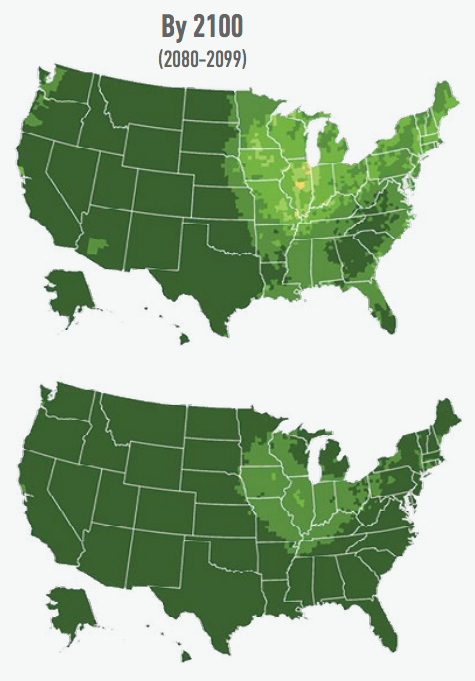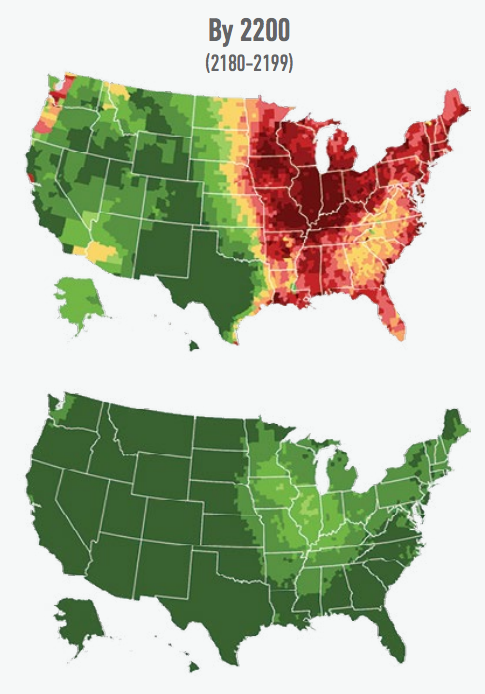When the subject of climate change comes up, I've become used to a dark response from locals: the coasts will flood, the Sun Belt will become uninhabitable, and everyone will move here next to all our fresh water.
But the future, under certain scenarios and projections, isn't so, um, optimistic. Not long ago I came across a climate risk assessment from a group spearheaded by former New York Mayor Michael Bloomberg, former U.S. Treasury Secretary Henry Paulson, and hedge fund manager Tom Steyer.
In it are maps of how many days per year something called the Humid Heat Stroke Index "could be so high that it will be unsafe for humans to remain outdoors." A full explanation of what that means is here, but the short of it is that heat stroke is "likely for fit individuals undertaking less than 1 hour of moderate activity in the shade," because the combination of heat and humidity would keep people from being able to sweat away a sufficient amount of heat.
That dangerous level of heat and humidity is considered Category IV, when the wet-bulb temperature is above 92 degrees. (For comparison, the Midwest heat wave of 1995 saw wet-bulb temperatures between 85 to 92 degrees.) As of their writing a Category IV day had been recorded just once, in Dhahran, Saudi Arabia.
Here are a couple maps of how often regions of the United States could see Category IV days, according to the models. The first assumes that carbon emissions continue on their current path; the second, if the U.S. embarked on "medium" emissions reduction.

Dark green is less than one Category IV day every ten years—under a "large emission reductions" scenario, the entire country is dark green. The lightest green means 3 to 5 every year; yellow, 5 to 10.
And dead-set in the middle, like a target, is Illinois.
So their models estimate that there would be about four days a year when my current bike commute to work could kill someone, within the lifetime of potential grandkids and the plausible lifetime of my existing daughter.
"The typical summer day in New Orleans is much more hot and humid than the typical summer day in Chicago, but the historical extreme has been that really awful heat wave [in the Midwest in 1995] in which hundreds of people died," says Robert Kopp, a climate scientist at Rutgers who co-led the research team behind the report. "It's a combination of warm air coming up from the gulf, and it having enough stagnation in the air so that humidity builds up towards the ground level. And in a lot of parts of the Midwest you also have it amplified by crops."
In fact, the highest heat index on record in the United States happened during that heat wave—in Appleton, Wisconsin, where an air temperature of 101 degrees and a dew point of 90 degrees combined for a heat-index reading of 148 degrees. And that was not a Category VI day on the HHSI, falling just short at 92 degrees. (There's some question as to how well substantiated that reading is, but the highest substantiated dew point on record was recorded in Moorhead, Minnesota on July 19, 2011, with a reading of 88 degrees, with a heat index of 134 degrees.)
It could get much, much worse. Here are the projections for the end of the next century. The top is the current emissions trajectory, the bottom is based on "medium" reduction of emissions.

Dark red means 30 to 45 days a year would be Category IV. In other words, under the worst-case scenario at the end of the next century, there would be the equivalent of a month every year when it would be dangerous to be outside, rendering the state (and other parts of the Midwest) all but uninhabitable during the summer. Granted, the latter two scenarios are a very long way away, and given that major countries have committed to reducing carbon emissions, a medium reduction is plausible, and a large reduction is possible.
"There's a huge difference between a high-emissions scenario and a low-emissions scenario. Either way there's going to be an increase [in dangerously hot days], but it's a much larger increase in the burn-all-the-coal future than if we try to get to a low-carbon future," Kopp says. "I am confident that humanity is not still going to be that [way]."



